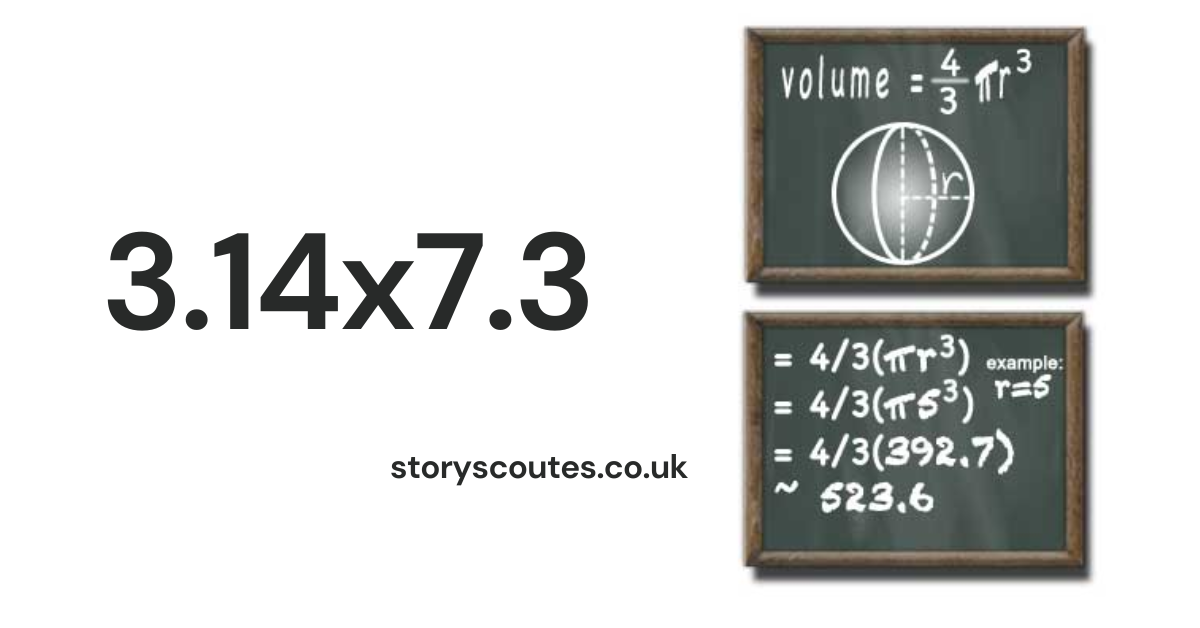3.14×7.3 – A Deep Dive into Mathematical Concepts
When we encounter the expression “3.14×7.3,” it might seem like a simple multiplication problem at first glance. However, this combination of numbers holds much more significance and opens up a world of mathematical concepts that are both fascinating and practical. In this comprehensive article, we’ll explore the meaning behind 3.14×7.3, its applications in real life, and how it relates to various mathematical principles. Whether you’re a student, a math enthusiast, or simply curious about numbers, this article will provide valuable insights and easy-to-understand explanations.
The Breakdown of 3.14×7.3
Let’s start by breaking down the components of this expression:
1. 3.14: The Value of Pi (π)
3.14 is a rounded version of the mathematical constant pi (π). Pi is a special number that represents the ratio of a circle’s circumference to its diameter. It’s an irrational number, meaning it goes on forever without repeating.
2. 7.3: A Variable Number
In this context, 7.3 could represent various things depending on the problem at hand. It might be a radius, a length, or any other measurement.
3. The Multiplication (x)
The “x” between 3.14 and 7.3 indicates that we’re multiplying these two numbers.
Why Is This Expression Important?
The expression 3.14×7.3 is significant because it often appears in calculations involving circles, spheres, and other curved shapes. It’s a fundamental part of many formulas used in geometry, physics, and engineering. Understanding this expression can help us solve real-world problems and appreciate the beauty of mathematical relationships.
Common Applications of 3.14×7.3
1. Calculating Circumference
If 7.3 represents the radius of a circle, then 3.14×7.3 would give us half the circumference. To get the full circumference, we’d need to double this result.
2. Finding Area
In the formula for the area of a circle (A = πr²), 3.14×7.3 could be part of the calculation if 7.3 is the radius.
3. Volume Calculations
When dealing with spheres or cylinders, 3.14×7.3 might be a step in calculating volume.
4. Angular Measurements
In problems involving angles and arcs, this expression could represent a portion of a circle’s measure.
The Significance of Pi (3.14)
Pi is one of the most famous mathematical constants. Its value of approximately 3.14 has been known for thousands of years, and it continues to fascinate mathematicians and scientists. Here are some interesting facts about pi:
1. Infinite Digits: Pi’s decimal representation never ends and never settles into a repeating pattern.
2. Ancient History: The concept of pi has been known for at least 4,000 years.
3. Pi Day: March 14th (3/14 in the month/day format) is celebrated as Pi Day in many countries.
4. Memory Champions: Some people have memorized tens of thousands of digits of pi as a mental challenge.
5. Ubiquity in Nature: Pi appears in many natural phenomena, from the shapes of rivers to the spiral of a galaxy.
The Role of 7.3 in Our Expression
While 3.14 is a constant, 7.3 is a variable in our expression. It could represent:
1. A Radius: In circle calculations, 7.3 might be the radius in units like inches or centimeters.
2. A Length: It could be the length of a rectangular prism or the height of a cylinder.
3. An Angle: In radian measurements, 7.3 could represent an angle.
4. A Scale Factor: In some problems, 7.3 might be used to scale up or down a circular object.
Practical Examples Using 3.14×7.3
Let’s look at some real-world scenarios where 3.14×7.3 might come into play:
1. Pizza Sizing
Imagine a pizza with a radius of 7.3 inches. To find its circumference, we’d calculate:
Circumference = 2 * π * r = 2 * 3.14 * 7.3 ≈ 45.84 inches
2. Cylindrical Water Tank
For a water tank with a radius of 7.3 feet, the cross-sectional area would be:
Area = π * r² = 3.14 * 7.3² ≈ 167.42 square feet
3. Circular Garden Design
If you’re planning a circular garden bed with a radius of 7.3 meters, you’d need enough edging for:
Circumference = 2 * π * r = 2 * 3.14 * 7.3 ≈ 45.84 meters
4. Spherical Playground Ball
To find the surface area of a ball with a radius of 7.3 cm:
Surface Area = 4 * π * r² = 4 * 3.14 * 7.3² ≈ 669.68 square cm
The Importance of Precision
While we often use 3.14 as an approximation for pi, it’s worth noting that in some cases, more precision is needed. For highly accurate calculations, more decimal places of pi are used. However, for everyday purposes, 3.14 is usually sufficient.
Exploring Related Mathematical Concepts
Understanding 3.14×7.3 can lead us to explore other important mathematical ideas:
1. Geometry of Circles
– Diameter: The length across a circle through its center (twice the radius).
– Circumference: The distance around the circle.
– Area: The space inside the circle.
2. Trigonometry
Pi plays a crucial role in trigonometric functions like sine, cosine, and tangent.
3. Calculus
The concepts of limits, integrals, and derivatives often involve pi in circular and periodic functions.
4. Physics
Many physics formulas, especially those dealing with waves and rotations, use pi.
5. Statistics
The normal distribution (bell curve) formula includes pi.
Tools and Technologies Related to 3.14×7.3
In today’s digital age, various tools can help us work with expressions like 3.14×7.3:
1. Scientific Calculators: Most have a dedicated π button for easy calculations.
2. Spreadsheet Software: Programs like Excel can handle complex calculations involving pi.
3. Math Education Apps: Many apps use visual representations to teach concepts related to pi and circular measurements.
4. 3D Modeling Software: These tools often use pi in calculations for curved surfaces and objects.
Common Mistakes and Misconceptions
When working with 3.14×7.3, it’s important to avoid these common errors:
1. Forgetting Units: Always include the appropriate units in your final answer.
2. Rounding Too Early: It’s best to keep more decimal places during calculations and round only at the end.
3. Misunderstanding Pi: Remember that pi is a ratio, not just a random number.
4. Confusing Diameter and Radius: Make sure you know which one you’re working with in a problem.
The Beauty and Mystery of Pi
The number pi has captivated mathematicians and thinkers for centuries. Its infinite, non-repeating nature has led to:
1. Ongoing Research: Mathematicians continue to calculate more digits of pi, pushing the boundaries of computation.
2. Philosophical Questions: The concept of infinity in pi raises interesting philosophical debates.
3. Artistic Inspiration: Pi has inspired music, poetry, and visual art.
4. Cultural Impact: Pi appears in popular culture, from movies to books, often symbolizing the beauty and complexity of mathematics.
FAQs About 3.14×7.3
Why do we use 3.14 instead of the full value of pi?
3.14 is a convenient approximation that’s accurate enough for many everyday calculations. It’s easier to remember and work with than the full, infinite decimal expansion of pi.
Can 3.14×7.3 ever be a whole number?
No, because pi is irrational, the result of multiplying it by any rational number (like 7.3) will always be irrational and thus not a whole number.
How is 3.14×7.3 used in everyday life?
This expression might be used in cooking (for circular pans), construction (for round pillars or pipes), or in various hobbies like crafting or gardening that involve circular shapes.
Is there a difference between 3.14×7.3 and 7.3×3.14?
In multiplication, the order doesn’t matter. Both expressions will give the same result due to the commutative property of multiplication.
How accurate is 3.14 as an approximation of pi?
3.14 is accurate to two decimal places. For most everyday calculations, this is sufficient. However, in fields like engineering or physics, more decimal places may be used for greater precision.
Can I use 3.14×7.3 in volume calculations?
Yes, this expression could be part of volume calculations for shapes like cylinders or spheres, where 7.3 might represent a radius or height.
How does 3.14×7.3 relate to the area of a circle?
If 7.3 represents the radius of a circle, then 3.14×7.3² would give the area of that circle.
Are there any memory tricks for remembering the digits of pi beyond 3.14?
Yes, many people use mnemonic devices or rhymes to remember more digits. For example, “How I wish I could calculate pi” gives the first seven digits (3.141592) based on the number of letters in each word.
Is pi (3.14) used in other number systems besides base 10?
Yes, pi can be expressed in other number systems like binary or hexadecimal, but its irrational nature remains the same.
How does 3.14×7.3 relate to the concept of radians in angle measurement?
In radian measure, the circumference of a circle is 2π radians. So, if 7.3 represents an angle in radians, 3.14×7.3 would be about 22.942 radians, which is more than a full rotation around a circle.
Conclusion
The expression 3.14×7.3 serves as a gateway to understanding fundamental mathematical concepts that shape our world. From the ancient discovery of pi to its modern applications in technology and science, this simple multiplication problem embodies the elegance and practicality of mathematics. Whether you’re calculating the size of a pizza, designing a round garden, or exploring advanced physics concepts, the principles behind 3.14×7.3 play a crucial role.
As we’ve explored in this article, this expression is more than just a numerical calculation. It represents the intersection of geometry, algebra, and real-world problem-solving. It reminds us of the beauty of mathematical constants like pi and the importance of precision in scientific thinking. Moreover, it demonstrates how basic mathematical operations can lead to profound insights about the world around us.
By understanding 3.14×7.3 and its implications, we gain not only practical skills for everyday calculations but also a deeper appreciation for the underlying patterns and relationships in nature and mathematics. Whether you’re a student, a professional, or simply someone curious about numbers, the concepts behind this expression offer a rich field for exploration and discovery.
Remember, mathematics is not just about finding the right answer; it’s about understanding the process, appreciating the logic, and seeing the connections between different ideas. The next time you encounter 3.14×7.3 or a similar expression, take a moment to consider its deeper meaning and the vast world of mathematical wonder it represents.






